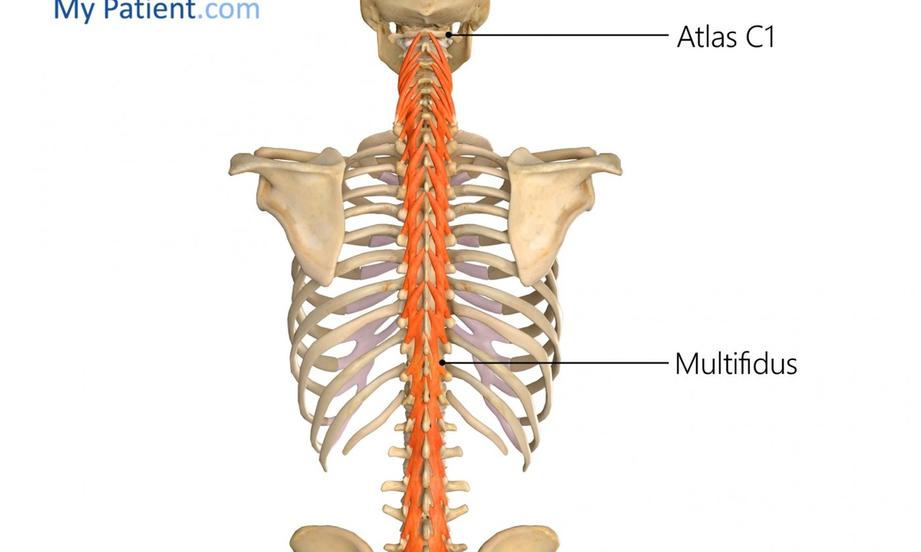B. Jeffrey Jolley, D. C., D.A.C.N.B.
Chronic low back pain affects millions of people worldwide. It is estimated that 80% of the population will experience low back pain in their lifetime—and now, the U.S. Centers for Disease Control and Prevention (CDC) has officially recognized the multifidus muscle as a major contributor to chronic spinal pain. This deep spinal muscle plays a critical role in stability, yet is often ignored in traditional rehab approaches.
At The Center for Total Back Care, we have long focused on multifidus dysfunction, and today, we are diving into why this muscle is the primary contributor to chronic spinal pain---why it is so vulnerable to injury—and how specific, targeted exercise can help restore its function.
What Is the Multifidus, and Why Does It Matter?
The multifidus is a small but mighty muscle that runs along your spine. It works behind the scenes to stabilize your vertebrae and keep you upright and to stabilize the spine during even the simplest movements—walking, sitting, bending, and turning.
Unlike bigger back muscles which allows us to perform gross movements, the multifidus has short fibers and a large cross-sectional area, making it ideal for fine control rather than generating large spinal movements. It spans only a few vertebral segments which allows for movement of each specific spinal segment allowing for gross spinal movements, but unlike the larger spinal muscles we control, we are unable to control the movement of each specific spinal segment. The multifidus is always “on,” and needs to have both strength and endurance, strength to be able to perform normal activities of daily living and to maintain an erect posture as well as the endurance to do it all day long. The only way to really rest the multifidus is to lie down, which is not realistic during the day. This makes the multifidus highly prone to fatigue and injury at the segmental level.
What Happens When the Multifidus Fails?
Research shows that people with chronic back and neck pain often have:
- Weakness in the multifidus
- Poor endurance
- Fatty infiltration (atrophy)
When the multifidus is unable to do its job, the body recruits’ larger spinal muscles to take over. These muscles were not designed for stability—and this overcompensation increases pressure on spinal joints, discs, and ligaments, worsening the problem and leading to a cascade of early spinal degeneration which often leads to bulging or herniated discs.
➡️ Bottom line: A weak multifidus can lead to instability, poor posture, muscle spasms, and chronic recurring pain.
Why Is Multifidus Dysfunction So Common?
Healthy individuals show little to no dysfunction in the multifidus. But in those with lower back pain it is a different story.
Factors that contribute to multifidus injury include:
- Trauma such as a car accident or fall (multifidus weakness is usually the residual pain that people experience following a car accident for the rest of their lives)
- Sedentary lifestyles (e.g., long hours sitting, looking at our phones or using screens)
- Poor posture
- Driving for extended periods
- Lack of spinal-specific exercise
Even after pain goes away, the multifidus is left in a weakened state—leaving the spine unprotected and vulnerable to future injuries.
Why General Exercise Isn’t Enough
While there is widespread agreement that active rehabilitation is essential for managing spinal pain, most exercise routines do not actually target the multifidus.
Here’s why:
- Traditional gym workouts activate larger muscles like glutes, hamstrings, or hip flexors—bypassing the multifidus
- Common floor exercises lack precision and control
- Standard machines are unable to safely isolate and progressively strengthen the deep spinal muscles
The MedX Medical Spinal Testing and Rehabilitation Machines.
At The Center for Total Back Care we use MedX Lumbar and Cervical Medical Spinal Testing and Rehabilitation Machines—which are clinically validated and built on decades of research.
MedX provides:
✅ Spinal strength testing with comparison to age and weight matched norms
✅ Targeted muscle isolation ✅ Progressive overload for safe strengthening ✅ Measurable outcomes for patient progress
This evidence-based approach allows us to identify multifidus weakness and safely rebuild strength, endurance, and stability which is essential for normal activities of daily living and demands of employment.
